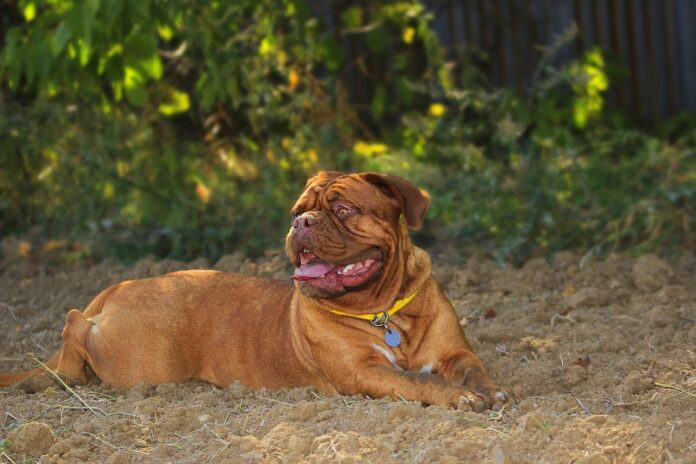
- Compare The Market’s pet experts reveal their tips on creating a summer-safe garden for your pooch this year.
- Top tips include creating cooling corners, avoiding chemicals in water features, and surfaces to steer clear of if you don’t have grass.
As the weather warms up, it’s inevitable that our dogs will be eager to head outside and play in the sun. However, it’s important owners know how to create a canine-friendly space in their garden for their four-legged friends to enjoy to minismise the risk of any dangers happening, such as heatstroke or burning.
To help, the pet experts at Compare The Market reveal tips on how owners can create a safe space for their pooch this summer.
Cooling corners
Patios are one of the recommended places to create cooling corners, as patio slabs can easily overheat in the sun and risk burning paws. Find a section that is shaded from direct sunlight and create extra shade by surrounding the area with pet-friendly plants such as roses, spider plants, or small trees. Place their cooling pad or canopy bed in the area and if you have the space, you could even create their own little den by placing a throw over two pieces of furniture that they can chill under.
Whilst your dog should be indoors when the UV radiation is at its highest, throughout the day spray the area every few hours with cold water to keep it cool, especially if they’ll be back outside later.
Paw-friendly surfaces
If you’re looking to spruce up your garden surfaces, and you’re not opting for grass, do be careful about the type of material you choose. For example, gravel can get stuck between paws whilst other surfaces, such as tarmac, absorb a lot of heat and will be uncomfortable, and potentially dangerous, for your dog to walk or sit on.
Pooch-proof your furniture
Depending on the material, outdoor furniture can become very hot in the sun and in turn could harm your pooch if they tend to lay on the furniture.
To prevent this, simply move the furniture to a shaded spot or put up a parasol to keep it cool and out of direct sunlight. Other options include using throws and blankets to cover the materials that get hot in the sun, however, check they’re suitable and safe for outdoor use first.
Watch out if you have artificial grass
Whilst artificial grass doesn’t get as hot as tarmac or paving, it still poses a risk to paws if it’s under direct sunlight. Treat it with the same caution as pavements by making sure your dog avoids walking on the area when it’s too hot and be sure to do the seven-second rule to check; hold your hand on the ground for seven seconds and if it’s too hot for you, then it’s way too hot for your pooch.
Avoid cleaning water features with chemical products
Throughout summer a lot of dogs love cooling down in water whether it’s to play or drink. If you have a water feature or pond in your garden, avoid using harmful chemicals and cleaning products so your dog doesn’t consume these and fall ill.
Be careful with compost
Some compost is packed with mouldy food and waste, which can produce harmful mycotoxins that are dangerous to dogs so it’s important to check what materials are included. If you’re gardening and using compost, always make sure it’s securely fenced off so your pup can’t access it.
Sunscreen
If your pooch likes to play outdoors in the sun, make sure you apply dog-friendly sunscreen to sensitive areas including the nose, ears, and stomach. This is especially important if they’re white, light-coloured, or patchy.
Limiting loud barks
The last thing you want to do is annoy your neighbours if your dog tends to bark at the postman or birds and cats. So, start training them now by regularly taking them into the garden, scattering treats to divert their attention and giving them praise to create good habits. Once summer comes, to keep them extra cool, when they don’t bark, reward them with frozen treats such as fruit.
Whilst it’s lovely to enjoy your garden with your furry friend during the summer months, dogs must not be outdoors once temperatures soar as Anna McEntee of the Pet Insurance team at Compare The Market explains: “Temperatures from 20 degrees and above can increase dogs’ risk of heatstroke and anything more than 24 degrees becomes a worrying risk and extreme caution must be taken.
“Signs of heatstroke include heavy panting, red eyes and gums, hot skin, vomiting, and your dog appearing uncoordinated, therefore it’s important that pet owners take extra precautions in the summer months and where possible, keep their dogs indoors when the heat rises. If you think your dog has heatstroke, contact your vet immediately.”
As we approach the summer months, if you find that your dog also tends to shed more during this time or has allergies, further helpful insight can be found here: https://www.comparethemarket.com/pet-insurance/content/dogs-that-shed-the-least/
Help keep news FREE for our readers
Supporting your local community newspaper/online news outlet is crucial now more than ever. If you believe in independent journalism, then consider making a valuable contribution by making a one-time or monthly donation. We operate in rural areas where providing unbiased news can be challenging. Read More About Supporting The West Wales Chronicle





















